For informative purposes, and in order to illustrate the notion of living heritage through concrete examples, the following list encompasses examples of cultural practices and forms of cultural expression in Egypt, Jordan, Lebanon and Syria.
This non-exhaustive and informal list was mainly taken from inventory reports carried out during Phase I of the MedLiHer project, and also includes the ICH elements that appear in the Convention Lists.
Egypt
The Al-Sirah Al-Hilaliyyah Epic (Inscribed in 2008 on the Representative List of the Intangible Cultural Heritage of Humanity)
Karaköz shadow puppet theatre
This tradition, which appeared in the Arab world in the twelfth century, may already have disappeared. A few years ago, I met one of its last practitioners in Cairo in Hassan Geretly’s drama group, al-Warsha. The figurines, in leather or cardboard, were some 20 centimetres high and are supported by stalks stuck horizontally in their joints. They are translucent and painted with natural pigments. This is an emergency project to be organized with neighbouring countries where shadow puppet theatre is in total decline.
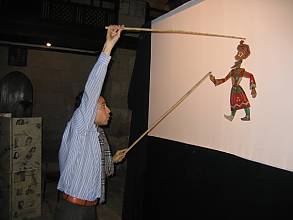
© Nabil Bahgt
Ramadan Lantern
Ramadan Lantern is one of the inheritance elements that are related to the every year celebrations of the month of Ramadan. The lantern is made out of sheets of colored glass and tin, in different sizes and forms. It is lit by a candle from the inside, or by electricity, when it has a large size. The lantern is also related to the children when they walk around in the streets and lanes, while singing the folkloric songs on such an occasion. The lantern use is spread now in ornamenting and lighting the streets during the nights of the month of Ramadan. Yet the production of the lantern started to recede…and a new extraneous form of cheap Chinese lanterns are presently used, and which are devoid of aesthetic style.
The Bamboo Clarinet ( Al Arghool)
The bamboo clarinet is an Egyptian folkloric wind instrument. It is made out of bamboo, it consists of two connected reeds; the first has six openings, and the second is longer in size. The singer can attach more canes when necessary. Hence the bamboo clarinet varies in size between 50 cm to 200 cm, yet the larger sizes started to recede among the folkloric singers. The instrument is played by blowing in a plectrum in the upper part of the two reeds. It is accompanied by a variety of folkloric song; the most famous among them is the roundelay.
The Waw
The art of waw flourished in the mamluk and Turkish era as people used it as an indirect way of resistance against the ruler. This art was created by the poet Ahmed Ibn Arous, born in Qenna in 1780; i.e. the mamluk era. That is why historians relate this particular kind of poetry to Upper Egypt, particularly Qenna Governorate. Ibn Arous used to recite this kind of poetry by starting his saying with a conjunction: and the poet said … in order not to relate what he recites to himself. Thus this kind of conjunction became repetitive and a distinguished feature of this poetry, later named the art of waw.
The art of waw is considered an oral folk poetry with a construction distinguished from the rest of poetry kinds. Waw poetry is consisted of 4 verses as the rhyme of the first verse parallels the rhyme of the third verse and the rhyme of the second parallels the forth.
Now, this art is fading after the loss of a significant number of its poets, except for a few folk old-aged poets. Accordingly, we are in a dire need to conserve and document this art for generations to come.
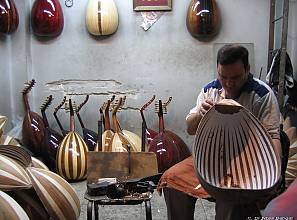
© Nabil Bahgat
Al-Angareeb
Al-Angareeb is a bed made from bare palm branches on a wooden structure then tied with leather. It was a well-known craft in Nuba long time ago as well as for ancient Egyptians. The scarcity of palm trees in the new Nuba and its lack of agricultural activities unlike the old town, this craft faded and only old-aged people are keen to revive their craft despite any difficulties they may face.
Tahtīb stick dance
This traditional practice is difficult to categorize: it is, according to those concerned, a martial art, a dance or a game. It is a group dance and the participants wield sticks: a group of “assailants” attack (with movements more exaggerated than in a real fight) the “attacked”, who try in turn to parry, dodge, and land a decisive blow on the adversary. This practice, which takes place in the open air, is accompanied by a group of musicians dominated by the mizmār (oboe), generally in groups of three, a kettle-drum known as the naqrazān which rests on the player’s chest and a tabla (chalice-shaped drum). The movements may be preceded or followed by a choreographed dance whose main figure is the moulinet.
Music of Nubia
The pentatonic system of these musical expressions has kept them apart from Egyptian musical trends and they are less well known than the artistic traditions of northern Egypt. They often involve drums and lyres accompanying the music and dance performances of Nubian groups. This tradition, which has now been influenced by trends in the renewal of light music singing, is in danger of totally losing its own inspiration, references and identity.
Classical art of the Egyptian renaissance: dawr
This was the most important musical form in nineteenth-century Egypt. During the performance, the singer, backed by a choir and an instrumental ensemble, modulates a poetic text either in classical Arabic or in the Egyptian Arabic dialect. The singer is often the author of the poem, which is generally divided into four verses. Musicologists, musicians and music groups outside Egypt are trying to revive this highly sophisticated classical tradition which influenced the greatest Egyptian singers of the twentieth century.
Jordan
The Cultural Space of the Bedu in Petra and Wadi Rum (Inscribed in 2008 on the Representative List of the Intangible Cultural Heritage of Humanity)
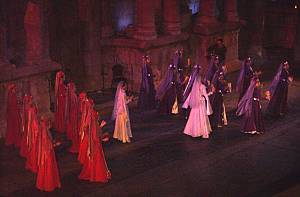
© Jouanah Ghori
Cherkess and Chechen oral heritage and cultural forms of expression
The customs and practices, traditions and folklore of the Cherkess and Chechen have enabled them to benefit from a culture of their own, in spite of their integration to the mainstream culture of the countries that have welcomed them. Their cultural and social traditions have therefore been protected and preserved, and still exist today; it is worth noting that this has not negatively influenced the culture of the host society in any way.
Traditional embroidery
The art of embroidery is commonly found in most regions of Palestine and Jordan. Women decorate their clothes with silk embroidery bearing geometrical motifs, or displaying plants or animals. These pieces find their roots in ancient religious trends and each pattern has a specific name or is embroidered for a particular event. They are mostly full of vivid colours, and each phase in life has its own colour. This art still exists and is increasing significantly, since the embroideries are now blended in to modern clothes and fabrics.
Weaving arts and techniques
This profession is one of the oldest in the world. The Prehistoric man would use tree leaves and animal hides to cover himself, before he discovered wool, linen (flax) and cotton. With time, he managed to develop tools and produce weavings adorned with patterns. The region of Balqaa and the village of Baoun and Ajloun are renowned for wool weaving. In the region of Karak, weavings from this Jordanian country-side al-Rif are also well known, and are mostly made by women.
Mansaf
Mansaf is a traditional cuisine Jordanian dish made of lamb cooked in a sauce of fermented dried yogurt and served with rice or bulgur. It is the national dish of Jordan, generally served on Fridays, after the prayer.
Lebanon
Folktales, legends and myths
Traditional crafts (cutlery-making, glass-working, silk-weaving, bell-making, tapestry, etc.)
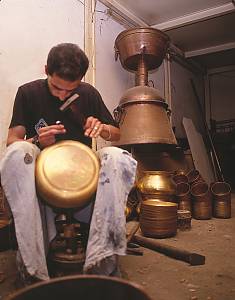
© Gérard Tohmé
Poetic songs of Mount Lebanon
These songs are based on two main genres, ‘atāba and mījāna. There are variations of ‘atāba in Syria, Jordan and Palestine, but in Lebanon it enjoys an exuberance unparalleled elsewhere. The mījāna on the other hand is a purely Lebanese tradition. Among the other genres, we should mention the mu’anna, the most marked by centuries-old Syriac metre and melody (mu’anna means “song” in Syriac) and highly respected by improvisational poets, offering a great variety of forms; shurūqī, a traditional Bedouin nostalgic, free and melismatic threnody (Syria and Jordan) performed by a soloist accompanied by the rabāb, and the qarrādi, a mixture with a Syriac undertone and Arabic influences.
Practices of the whirling dervishes of Tripoli
These dervishes belong to the Qadiriya brotherhood of Tripoli. They claim to follow the teaching of Abed al-Qādir al-Kilānī, like the zaoiyya Qadiriya of Aleppo, but their specific songs and dances are distinctive.
Syria*
Al-Qudud of Aleppo (also Halabi Qudud)
Old popular tunes and songs used on different occasions, religious and secular, by artists and non-professional practitioners.
The Damascene Arada
Joyful processions of men in the streets of the town, accompanied by music and singing, halting at public squares for with sword dancing, performed on various occasions (for instance accompanying a bridegroom to the place of wedding, celebrating neighbourhood festivities, parading boys after circumcision).
Samah dance in Aleppo
Dance traditionally used in religious ceremonies of Sufi orders, nowadays mainly performed in some popular festivities and on stage.
Karakoz Shadow Theatre
A theatrical tradition involving leather (or carton) puppets manipulated by a puppeteer who adapts traditional texts to the events of the day; virtually extinct in Syria*, but with good chances for successful revitalization.
Traditional silk brocade production
Common ICH elements
Several cultural practices and forms of cultural expression are common to some of the four MEDLIHER partner States* and to other countries of the region that are linguistically and culturally close:
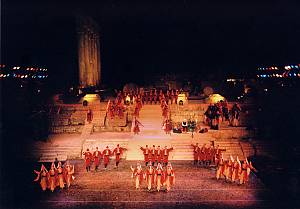
© Fahed Abdallah
Music and songs of classical Arab music: waṣla, muwashshah, qasida, ghazal, and so on (all countries in the region)
These forms of classical music fall within the scope of waṣla, a series of sophisticated songs preceded and interrupted by composed or improvised instrumental sections (taqsīm). They are accompanied by the takht, a group with at most five instrumentalists, and a choir of two or three singers. The singer improvises on classical poems according to an age-old vocal technique enriched by a timeless musical aesthetics and the melismas of sacred singing. The random vocalizing is accompanied by one or more instruments either with no backing rhythm or according to a rhythmic cycle with the backing of a repetitive bass line (ostinato).
Among the songs, the most famous are the muwashshah, a sung musical form that is quite short, with fixed form, of five or seven stanzas with varying rhymes, which follow each other in a single suite so as to amplify the volume and enrich them. This genre, created in the ninth century in al-Andalus by Ibn Mu’afa al-Qabrí, is one of the most notable Syrian traditions. We should also refer to the qasida, a poem with a single rhyme and single metre of two hemistichs of equal length dealing with a single subject developed to a conclusion; the qasida is often a panegyric written and sung in praise of the tribe or lauding a powerful individual (it is then called a madīh). There is also the ghazal, an often courtly love song with a sometimes mystical resonance.
This increasingly neglected element may be found in Syria* as well as in Lebanon and Egypt.
Bedouin songs (all countries in the region)
These songs are the province of musicians, poets and storytellers, some of them nomads, living in the four countries. They recount the exploits of ancient Bedouin tribes and include several genres:
- Long poems sung by a shā’ir who improvises rhythm and melody: ‘atāba (the word expresses the idea of a friendly reproach, it is the expression of a pain and grief whose causes remain unknown) and shurūqī (this style refers to its region of origin, the steppe (bādiya) of eastern Jordan) in which the shā’ir accompanies himself on the rabāb (a string instrument with a single string bow); mawwāl (type of melismatic singing), accompanied by the derbake (drum) and by sahja (hand-clapping) or debkeh (foot-tapping).
- Syllabic songs sung a cappella or accompanied by the rabāb and related to a given activity: huda (songs of horsemen and camel drivers); hjeyni (songs of camel drivers), and dahiya or sahja (hand-clapping), halaba (refrain) and samer (evening conversation) and debkeh, the men’s dance sometimes sung by women.
- Zajal: These poems of Arab-Andalusian origin are performed by folk groups and accompanied bythe flute shabbaba or nāy.
- Ughniya: These are series of folk songs accompanied by the simsimiyya lyre and performed in cities and by the fishing community of Aqaba. They cover simsimiyya repertories echoing those of the Red Sea and Sinai desert.
Traditional medicine (all countries in the region)
Traditional medicine belongs to the realm of popular beliefs and distinguishes itself from other beliefs by its link to health and sickness. Many resort to traditional medicine to face health problems with the help of natural products. Man’s relation to nature is a noble and everlasting one: throughout the centuries, man has used tree leaves and animal hides to protect himself against the harmful cold and heat. He has fed himself with fruit to satisfy his hunger and water springs to quench his thirst. Trees have provided him with shelter and he has used different varieties of herbs and plants to protect himself against illnesses.

© Christophe Graz
Al-hakawātī (Syria* and Egypt)
These are stories told by a storyteller in particular cafés at a specific time of the day or night. The storyteller interacts fully with the audience, who intervene in the telling of the story. The storyteller and the audience are thus both actors in this epic which can go on for weeks, or even months.
Arab calligraphy (at least Syria* and Egypt)
This is the art of drawing Arabic characters. Arabic writing is characterized by characters that are linked together which allows patterns to appear, geometrical or round, and to intertwine.
The art of the arabesque which decorates mosques and palaces uses calligraphy as well as embellishments adorning some books, including the Koran. Many Muslim artists have turned towards this art after the Islamic legislation forbade the representation of human beings and animals, in particular in the Holy sites and in Korans.
Manufacturing the Oud (Syria*, Egypt, Lebanon)
The Oriental Oud is an age-old stringed instrument. In Arabic the Oud refers to a five-stringed wooden instrument to which a sixth string can be added and whose sound level covers two and a half octaves. The Oud is one of the main stringed instruments in Arabic music.
The dabke, a popular dance in Lebanon, Syria* and Jordan (and the Palestinian Territories)
The dabke is the dance that is common to the countryside of all these countries of the Levant. In Lebanon, it is defined by the way the dancers line up in arcs of circles, arms entwined, moving round clockwise, and stamping their feet on the ground. There are several forms of dabke in Lebanon, Syria* and Jordan, and they differ according to where and why they are performed and who performs them.
*Given the situation in the Syrian Arab Republic, the activities led in Syria in the project MedLiHer have been suspended since October 2011.